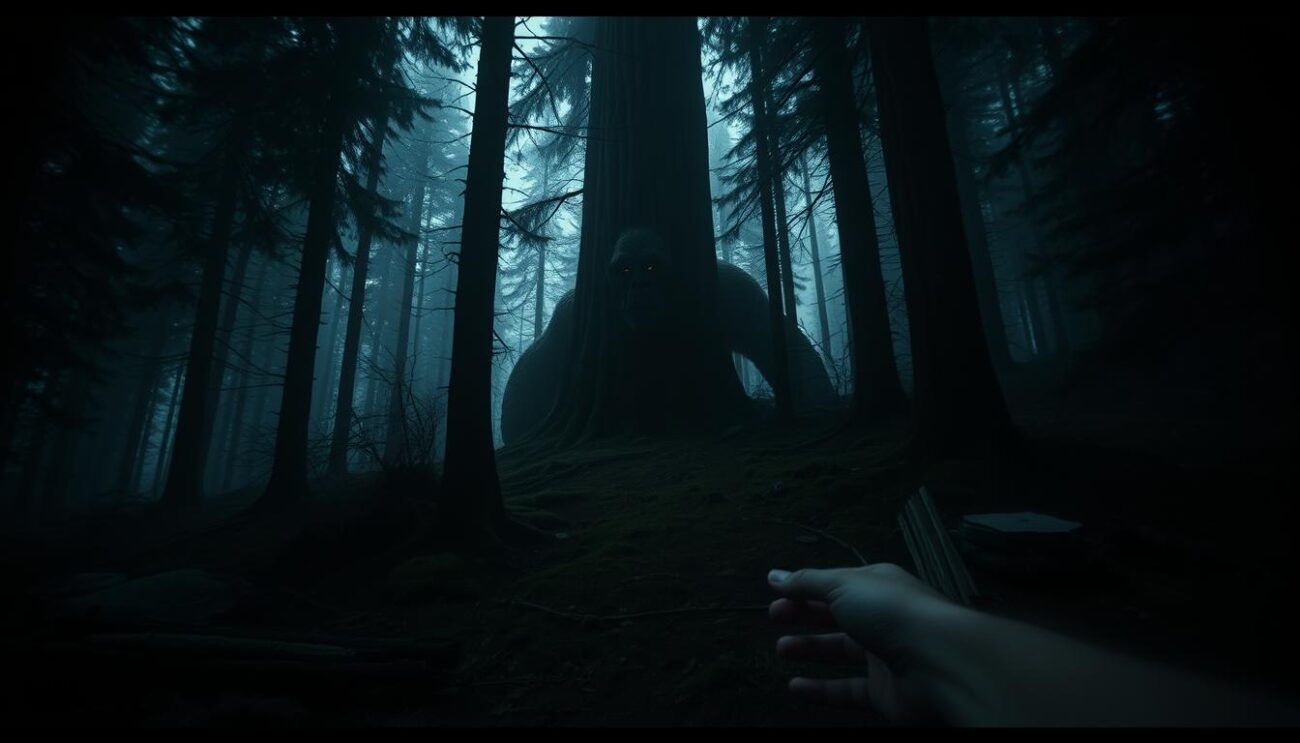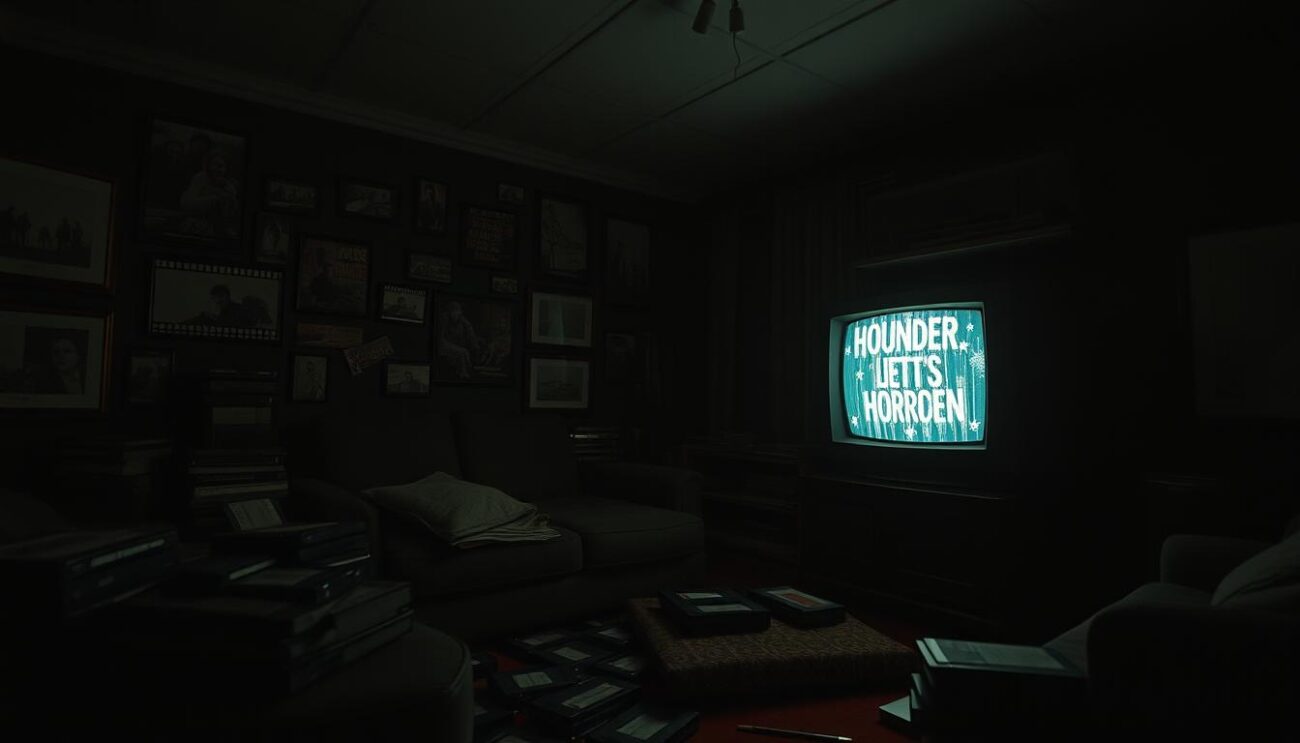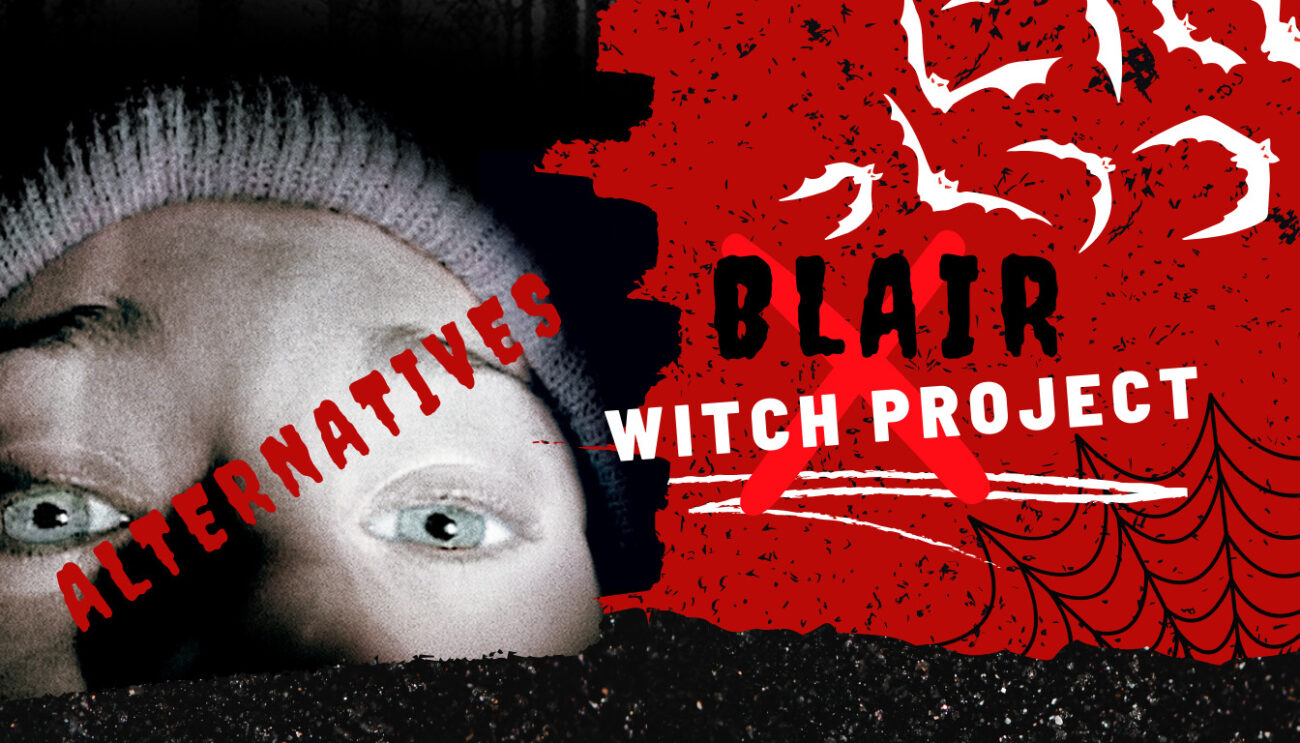The Best Found Footage Movies You Need to Watch

I love horror movies, and found footage films are my favorite. They make you feel like you’re right there with the characters. This makes the scares even more real. Classics like “The Blair Witch Project” and newer hits like “Host” are unforgettable.
Found footage movies have evolved a lot. New tech and creative ideas let filmmakers do amazing things. Movies like “Rec” and “Creep” are super scary. And “Unfriended” shows how you can tell stories in new ways.
In this article, we’ll explore the best found footage horror movies. We’ll look at classics and new thrillers. Get ready for some serious scares and thrills.
Key Takeaways
- Found footage horror movies offer a unique, immersive experience that draws the audience into the narrative.
- “The Blair Witch Project” was a groundbreaking film that paved the way for the subgenre’s popularity.
- Technological advancements have allowed filmmakers to push the boundaries of found footage storytelling.
- The best found footage movies, such as “Rec,” “Creep,” and “Unfriended,” have left a lasting impact on the horror genre.
- This article will explore the most iconic and influential found footage films, from low-budget masterpieces to high-concept thrillers.
The Blair Witch Project: The Groundbreaking Found Footage Horror Film
In 1999, “The Blair Witch Project” changed the found footage horror genre. Directed by Daniel Myrick and Eduardo Sánchez, it tells the story of three film students. They go into the woods to find the Blair Witch, but they vanish. A year later, their footage shows the scary events that happened.
This film stands out because of its new way of telling stories. It was shot like real documentary footage. This made the movie feel very real and scary, making people wonder what was real and what wasn’t.
The film’s success came from its unique story and clever marketing. Myrick and Sánchez made a website that made the Blair Witch legend seem real. They included fake police reports and interviews. This made people think the footage was real, creating a lot of excitement before the movie came out.
“The Blair Witch Project” made almost $250 million, starting with just $60,000. It became one of the most successful found footage movies. Its success led to other hits like “Rec,” “Cloverfield,” and the “Paranormal Activity” series.
“The Blair Witch Project” shows the power of new ideas in movies. Its impact is still felt today, inspiring many filmmakers.
Paranormal Activity: Sparking a New Era of Found Footage Thrills
In 2007, a low-budget horror film called Paranormal Activity hit the scene, bringing back the found footage craze. It tells the story of a young couple who face paranormal issues in their new home. They use cameras to capture the haunting, pulling viewers into their scary journey.
Paranormal Activity’s success comes from its simple yet effective approach. Director Oren Peli, a former software programmer, used quiet camera movements and an eerie feel to build tension. The film’s real characters and their true reactions make it feel very real, mixing fiction with reality.
The Franchise’s Impact on the Horror Genre
The Paranormal Activity franchise has made over $890 million worldwide, making it a big name in horror. It made the found footage style popular, leading to more films using this raw, immersive style.
Oren Peli’s work has had a big impact on horror. He produced the Insidious series and Chernobyl Diaries, showing his skill in creating scary, engaging films that fans love.
Analyzing the Effectiveness of the Film’s Minimalistic Approach
Paranormal Activity shows the power of less in horror. It leaves things to the viewer’s imagination, making fear and anticipation grow. The film’s ability to scare with little is a lesson in how to tell scary stories well.
The found footage style is key to the movie’s success. It makes the story feel real and relatable. By seeing the events through the characters’ cameras, viewers feel like they’re part of the horror, making it even scarier.
Cloverfield: Found Footage Meets Kaiju Chaos
In 2008, Cloverfield hit the scene, mixing found footage horror with a kaiju attack. Directed by Matt Reeves and produced by J.J. Abrams, it follows friends in New York City during a monster invasion.
The film’s unique idea and clever marketing sparked huge interest. Cloverfield pulls you into the disaster, shown through a personal camcorder found by the U.S. Department of Defense.
Cloverfield stands out by mixing chaos, mystery, and revealing information slowly. It keeps you hooked by showing the survivors in famous New York City spots. The cast’s performances make you feel the characters’ fear and desperation as they face “Clovie.”
“I wanted to give America its own monster, and I wanted a story that was about a personal, intimate, ground-level experience.” – J.J. Abrams on the inspiration behind Cloverfield.
Despite found footage’s limits, Cloverfield builds tension with weird visuals and sounds. The climax, with the military’s “Hammerdown Protocol,” leaves you wondering about the characters and monster’s fate. This adds to the fear and realism.
Cloverfield is a game-changer in horror, blending found footage with kaiju action. Its unique idea and execution still thrill fans, making it a must-see for horror lovers.
Trollhunter: A Unique Blend of Found Footage and Nordic Folklore
“Trollhunter” is a standout in the best found footage horror movies category. This 2010 Norwegian film combines the raw feel of found footage films horror with Nordic folklore. It offers a unique and unforgettable viewing experience.

André Øvredal directed “Trollhunter” on a budget of NOK 19 million ($3.5 million). It follows students investigating mysterious bear killings in Western Norway. They soon discover a secret government agency managing the country’s troll population.
Exploring the Film’s Satirical Elements
“Trollhunter” uses satire to great effect. It mocks bureaucracy and government secrets, adding dark humor to the story. The absurdity of the trolls and the agency’s efforts creates both tension and laughter.
“No trolls were harmed during the making of this movie.”
The Impressive Visual Effects in a Found Footage Context
Despite being a found footage horror movies film, “Trollhunter” has impressive visual effects. The trolls, inspired by Norwegian tales, are designed with care. Their transformation into stone when exposed to sunlight is a highlight.
The film runs 104 minutes and made NOK 24 million ($4.2 million at the box office. It shows that found footage films horror can be both hits and critical successes. Its mix of mythology, satire, and thrills makes it a top best found footage horror movies choice.
The Bay: An Unconventional Found Footage Eco-Horror Tale
“The Bay” is a standout in found footage horror movies. It combines eco-horror with a unique story. Directed by Barry Levinson, it takes place in Claridge, Maryland, during the 4th of July Crab Festival. A deadly outbreak starts, causing panic and chaos.
This film is different because it’s told like a documentary. It uses many cameras to feel real. From iPhone footage to surveillance videos, it tells a story of pollution’s harm.
“The Bay” is a prime example of how found footage horror can be used to deliver a powerful message about environmental issues while still delivering genuine scares.
Levinson shot the film in just 18 days with 21 cameras. Despite a $2 million budget, it shows the horror of a pandemic. The audio and picture quality add to the found footage feel.
The movie mixes science and fiction well. It uses 80 to 85 percent real scientific facts. The setting, the Chesapeake Bay, is shown as very polluted, mirroring real environmental issues.
Though it didn’t do well at the box office, “The Bay” is a must-see. Its unique style and political commentary make it a thought-provoking horror film.
Found Footage Movies: Pushing the Boundaries of Immersion and Realism
Found footage movies have changed the horror genre. They offer a unique and immersive experience. These films make viewers feel like they’re seeing real events.
They use a raw, unpolished look and focus on real stories. This makes the best found footage horror movies feel very real. It pulls viewers into the story.
The Subgenre’s Ability to Create Authentic, Relatable Experiences
Found footage movies are great at making characters and situations feel real. They show the story through a handheld camera. This makes viewers feel like they’re right there with the characters.
It creates a strong bond between the audience and the characters. This bond makes the movie more impactful.
Recent movies like Deadstream show the subgenre’s growth. It’s a horror-comedy that feels like Evil Dead and Tucker & Dale vs Evil. With its found footage style and 87-minute length, Deadstream is a standout.
Examining the Technical Challenges of Creating Convincing Found Footage
Making a believable found footage movie is tricky. Filmmakers must balance authenticity and storytelling. They plan each shot and edit carefully to keep the illusion alive.
Handheld cameras, diegetic sounds, and smooth editing are key. They help create an immersive experience that feels real.
“Found footage films have the power to transport viewers into the heart of the story, making them feel as if they are living through the events alongside the characters.”
As technology gets better, more filmmakers try found footage. They mix genres and use new storytelling ways. This makes found footage movies exciting and scary for years to come.
The Evolution of Found Footage: From The Blair Witch Project to Host
The found footage genre has grown a lot since The Blair Witch Project in 1999. This film made $248 million with just $60,000 spent. It showed the huge potential of found footage horror and opened a new filmmaking era.
As it became more popular, films like Paranormal Activity and Cloverfield pushed the genre’s limits. They offered exciting and immersive stories. Paranormal Activity was especially profitable, beating many films in box office success.
Tracing the Subgenre’s Development Over the Years
Found footage films have changed over time, using new techniques and fresh views. District 9 won praise at the Oscars for its creative use of fake news footage. This showed the industry’s growing respect for found footage.
“The Blair Witch Project avoided expected narrative tropes about men outnumbering a woman in the woods, subverting gendered behavior expectations and embracing psychological drag.”
The genre also challenges old gender roles. The Blair Witch Project had a female director and broke away from usual gender norms in its story.
Technological Advancements and Their Impact on Found Footage Filmmaking
Technology has improved, and so has found footage filmmaking. Smartphones and social media have opened new ways to tell stories. Host, made on Zoom during the pandemic, is a great example. It shows how filmmakers can adapt and create great stories with new tech.
From The Blair Witch Project to Host, found footage has grown and changed. It keeps pushing horror cinema’s limits. With new tech and ways to tell stories, the future of found footage looks very promising.
V/H/S and Its Sequels: Anthology Horror in the Found Footage Format
The V/H/S franchise is a top pick in horror movies, known for its unique style. It started with the 2012 film V/H/S. This movie tells the story of thieves who find a collection of creepy VHS tapes.

The success of V/H/S led to two sequels: V/H/S/2 and V/H/S: Viral. Each film brings new horror stories, showing the genre’s creativity. The first three movies made over $2.8 million at the box office.
V/H/S/2 got good reviews but didn’t do as well at the box office. V/H/S: Viral got mostly bad reviews and made less money. But the series kept going, with V/H/S/94 getting the best reviews.
“The V/H/S franchise has become a beloved staple in the found footage horror genre, offering a unique anthology format that keeps audiences engaged and on the edge of their seats.”
The franchise has grown with two spin-off movies and a miniseries. SiREN got good reviews, and the V/H/S: Video Horror Shorts miniseries was praised. But Kids vs. Aliens got mixed feedback.
With seven films, two spin-offs, and a miniseries, V/H/S has made a big impact. It’s known for its creative stories and commitment to the genre.
Searching and Unfriended: Bringing Found Footage to the Digital Age
Technology keeps changing, and so does horror movies. Films like Searching and Unfriended now tell stories on computer or phone screens. These new ways of storytelling have made the genre exciting again.
Searching, directed by Aneesh Chaganty, is a 2018 thriller. It follows a father searching for his missing daughter through social media and video chats. Despite a small budget, it made over $75 million worldwide, showing its success.
Adapting the Subgenre to Fit the Era of Social Media and Online Communication
Levan Gabriadze’s 2014 film Unfriended uses a Skype call to tell a horror story. It shows a ghost haunting a group of friends. This approach makes the story feel real and close to the viewer.
“The use of laptop cameras in films like Unfriended and Searching creates an intimate viewing experience, with the films being predominantly told in close-up shots.”
The Effectiveness of Screen-Based Storytelling in Found Footage Films
These movies show how well screen-based stories work in horror. They use technology to make stories that feel real and relatable. As technology advances, we’ll see even more creative found footage movies.
The Future of Found Footage: Where the Subgenre is Headed
Found footage movies are changing, with new ways to tell stories. In 2023, we saw movies that mix first-person views with regular stories. This shows a new path for the genre. New tech and the use of personal devices and social media are also making these movies more exciting.
One big trend is analog horror. It uses simple sounds and stories to scare us. Shows like The Mandela Catalogue and Local 58 are very popular. They use audio logs and stories to build a scary world.
Malibu Horror Story shows how found footage has changed over time. It’s now part of true crime stories. Marui Video, from Korea, mixes horror with other styles, showing the genre’s global reach.
In 2024, we expect even more creative found footage movies. Mind Body Spirit, Frogman, and Invoking Yell are just a few examples. Director Christopher B. Landon thinks the genre will grow, exploring new themes and styles.
The future of found footage might mix fiction with real events. This could make movies even more real and engaging for viewers.
As filmmakers keep trying new things, found footage will stay a key part of movies. It offers thrilling and fresh ways to tell stories, keeping audiences excited.
Conclusion
Found footage horror films have changed the horror genre since “The Blair Witch Project” in 1999. It made over $248 million worldwide. The early 2000s saw hits like “Paranormal Activity”, “Cloverfield”, and “REC”. These films showed how found footage can make movies scary and real.
As the genre grew, filmmakers tried new things. “Chronicle” (2012) mixed found footage with superheroes. “Unfriended” (2014) and “Searching” (2018) used computer screens for their stories. These examples show found footage can work in many genres.
But, the subgenre has seen ups and downs. The same old style got old, and creativity waned. The “Paranormal Activity” series is a prime example. Yet, films like the V/H/S sequels and “Incantation” (2022) brought fresh ideas.
Even though found footage isn’t as big as it once was, its influence is huge. The best films in this style have shown it can be both unique and frightening. As filmmakers keep trying new things, found footage might just make a comeback.
FAQ
What was the first found footage horror movie that popularized the genre?
A: The Blair Witch Project (1999) was a game-changer. It used viral marketing to make us believe it was real. This movie started a trend in found footage horror.
What makes found footage movies so effective in the horror genre?
Found footage movies feel real because they’re shown as if recorded by the characters. This makes us feel like we’re part of the story. It makes the scares more intense.
What are some of the most successful found footage horror franchises?
A: Paranormal Activity (2007) was a huge hit, making over 0 million. The V/H/S series, starting in 2012, also did well. Each part has new horror stories.
How have technological advancements impacted the found footage subgenre?
Smartphones and social media have changed found footage movies. Films like Searching and Unfriended use screens to tell stories. They reflect our digital lives.
What are some found footage movies that blend the genre with other styles or themes?
A: Cloverfield (2008) mixes found footage with monster movies. Trollhunter (2010) combines found footage with Nordic folklore and dark humor.
What challenges do filmmakers face when creating a convincing found footage movie?
Making a believable found footage movie is tough. Filmmakers need to plan shots and edits to keep it real. They must balance realism with a good story.
How has the found footage subgenre evolved since its early days?
Since The Blair Witch Project in 1999, found footage has changed a lot. Early movies used the format’s novelty. Now, filmmakers innovate with new ideas and digital storytelling.
